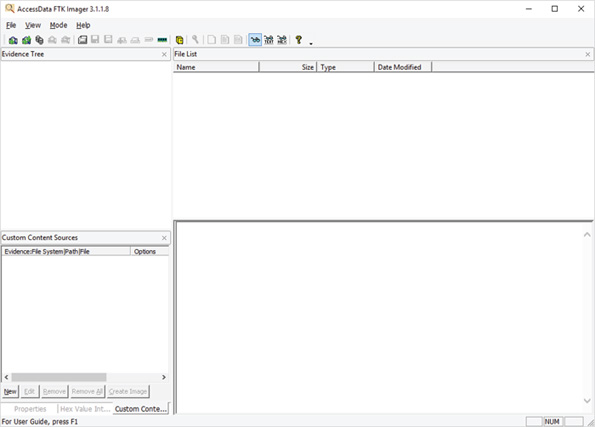

- #Accessdata ftk imager md5 how to#
- #Accessdata ftk imager md5 full#
- #Accessdata ftk imager md5 Pc#
- #Accessdata ftk imager md5 download#
- #Accessdata ftk imager md5 free#
You always have to get the hashes of every single file for that sort of devices. The image hash value does not have trust by itself because the changes of data in SSD drives. Remember, I used for this article a USB drive to explain the process, the real scenario was with a Solid State Disk SSD. Please be aware also when this sort of cases is for law purposes. txt file with the summary (Image 13) in the folder where is stored the image’s files, including features of the disk like the image’s hash values. When the process of acquiring the image is done, FTK creates a. Running the command and options above, the following will show even with the ongoing process (Image 12):
#Accessdata ftk imager md5 full#
examiner, your full name or acronym of your name.ġ0. description, any comment for your case.ĩ. compress 6, level of compression for the disk image.Ħ. frag 1500MB, each file will have a maximum of 1500 Megabytes, ftkimager split the entire image in the necessary files with this size.ĥ. e01 – The format of the image, this kind is for Encase image file format.Ĥ. home/Ubuntu/Desktop/Folder/image – The destination of forensic image files, Folder is where the files will be storage, image is the name of the file.ģ. dev/sdb – Is the source, the disk to acquire the image.Ģ. The full command of this example is the following (Image 11):ġ. Comparison Windows – Linux options to document the case Comparison Windows – Linux options to acquire the forensic image Some of the options obviously are the same if you’ve used FTK Imager Lite in Windows, I’m going to show you those Linux commands with a comparison of the options in Windows OS.
#Accessdata ftk imager md5 free#
For example, for a target hard disk with 500 GB, you should have another disk with at least 500 GB of free space to get the forensic image files.įtkimager disk_target_to_acquire destination_path options At this point you can choose any location where you want to copy the files but, for really hard disks with lots of GB, the best way is using an external USB hard disk with enough space to assure the image. I created a folder named “Folder” in Ubuntu’s desktop to make there the FTK’s forensic image. In this lab this is the source device to acquire the image. The image above (Image 8) is an example of a Kingston USB memory with 8 GB. It will show more information about the hard disks. The best way to do it is by running the fdisk -l in the terminal. I recommend that you make completely sure which is the target disk to get the image. To acquire the forensic image, check where the hard disk is mounted by typing ftkimager -list-drives. To get the full help of FTK type ftkimager –help and you will see something like this (Image 6): Ubuntu recognizes and executes FTK, just type in the terminal ftkimager. Now you are able to run the program wherever you are. Moving FTK Imager CLI to execute anywhere In live mode just hit the Enter key, because there is no password.

#Accessdata ftk imager md5 download#
Download FTK, by default it goes to the Downloads folder.ġ. Follow this steps to take the program to the right location.ġ. The version I used was 圆4, version for x86 processors is available too.Īfter downloading, the program itself does not execute because you have to move to a specific path. The laptop did not respond, the only thing that worked was Ubuntu.įirst thing, download FTK Imager for Linux ( ), looking for “Command Line Versions of FTK”.

At this point, I want to tell you I tried to boot that laptop with several Linux forensic distributions like Kali, Caine and Deft, I didn’t try REMnux for instance. I used the latest release of Ubuntu Desktop 16.04 ( ). I tried switching a lot of configurations in the BIOS of that laptop, but the Mini Windows XP never booted, so I had to move to Linux. It comes with a light Windows XP version called “Mini Windows XP” and I planned to the use FTK Imager Lite for Windows ( ) which runs stable when I have to acquire the image in situ (visit to another place or when there are limitations to move the hard disk at your office). Well, I couldn’t connect the disk to any other device, so I decided to fire up the laptop using the Hirens Boot CD ( ). Until one day, a laptop with a Solid-State Drive (SSD) came to me, and it had more RAM than a hard disk (see the Image 1 below).
#Accessdata ftk imager md5 Pc#
The way to get the image for me most times is by removing the disk of the pc and connect it to the forensic station using a write blocker device.
#Accessdata ftk imager md5 how to#
Day by day, the profession of digital forensics implies a challenge about changes of technologies, here I’m going to explain how to acquire a forensic image using FTK Imager in command line interface (CLI) and Linux.


 0 kommentar(er)
0 kommentar(er)
